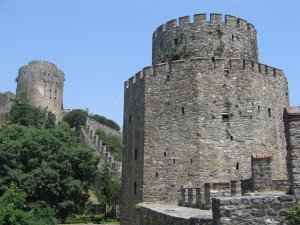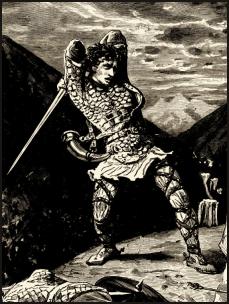Jack7
First Post
Sailing to Byzantium
That is no country for old men. The young
In one another's arms, birds in the trees
- Those dying generations - at their song,
The salmon-falls, the mackerel-crowded seas,
Fish, flesh, or fowl, commend all summer long
Whatever is begotten, born, and dies.
Caught in that sensual music all neglect
Monuments of unageing intellect.
An aged man is but a paltry thing,
A tattered coat upon a stick, unless
Soul clap its hands and sing, and louder sing
For every tatter in its mortal dress,
Nor is there singing school but studying
Monuments of its own magnificence;
And therefore I have sailed the seas and come
To the holy city of Byzantium.
O sages standing in God's holy fire
As in the gold mosaic of a wall,
Come from the holy fire, perne in a gyre,
And be the singing-masters of my soul.
Consume my heart away; sick with desire
And fastened to a dying animal
It knows not what it is; and gather me
Into the artifice of eternity.
Once out of nature I shall never take
My bodily form from any natural thing,
But such a form as Grecian goldsmiths make
Of hammered gold and gold enamelling
To keep a drowsy Emperor awake;
Or set upon a golden bough to sing
To lords and ladies of Byzantium
Of what is past, or passing, or to come.
That is no country for old men. The young
In one another's arms, birds in the trees
- Those dying generations - at their song,
The salmon-falls, the mackerel-crowded seas,
Fish, flesh, or fowl, commend all summer long
Whatever is begotten, born, and dies.
Caught in that sensual music all neglect
Monuments of unageing intellect.
An aged man is but a paltry thing,
A tattered coat upon a stick, unless
Soul clap its hands and sing, and louder sing
For every tatter in its mortal dress,
Nor is there singing school but studying
Monuments of its own magnificence;
And therefore I have sailed the seas and come
To the holy city of Byzantium.
O sages standing in God's holy fire
As in the gold mosaic of a wall,
Come from the holy fire, perne in a gyre,
And be the singing-masters of my soul.
Consume my heart away; sick with desire
And fastened to a dying animal
It knows not what it is; and gather me
Into the artifice of eternity.
Once out of nature I shall never take
My bodily form from any natural thing,
But such a form as Grecian goldsmiths make
Of hammered gold and gold enamelling
To keep a drowsy Emperor awake;
Or set upon a golden bough to sing
To lords and ladies of Byzantium
Of what is past, or passing, or to come.
I. This is a brief description of my D&D game milieu, and how it works. I decided to put it here because the Plots and Places Forum seems to be for campaign and plot development instead of for settings. If you want to discuss this setting in this thread then feel free to do so. I’ll add things to it as I go along.
Two Worlds: There are actually two worlds, our world, circa 800 AD, and the setting upon our world is semi-historical. That is most of the things that happen in our world, as the setting for the game, involve real world historical figures, cities, cultures, religions, technologies, societies, military forces, economic systems, and so forth of that era. The exceptions to the historical rule are the introduction of the player characters themselves (who often encounter real people of the time, like Charlemagne, as well as legendary figures like Roland).
In addition there is another world, geographically identical to our own but inhabited by completely different creatures and operating by different rules. This other world will be described later in this thread but creatures such as Elves and Giants inhabit it (though they do not call themselves that) and only a few human refuges from our world can live there. Most humans who travel to that world do so by accident and become far longer lived than normal humans but most also become sterile over time. A very, very few have over time interbred with the local populations on that other world but it is an extremely rare occurrence when that happens and the offspring sometimes fall prey to strange diseases and fail to mature. Some of the off-spring who do live past adolescence are also naturally sterile or barren. As a result the human population, which never accounted for more than a few hundred individuals is now nearly extinct.
As well as Elves and other such creatures monsters also inhabit that other world. They sometimes escape their own world and come to ours.

The Setting Upon Earth (Terra): The City of Constantinople is the center of most activity in the setting on our world. It lies along one end of the Silk Road and Byzantine contacts run throughout Western Europe, Central Europe, and Eastern Europe, as well as into Russia, the Near East, Syria, Persia, and into parts of the Orient, and finally down into Egypt, and into Northern and Eastern Africa. As far as sea travel much of the Mediterranean is open to them as well as the Black Sea. Giving the players and their characters a wide area of territory in which to explore and operate.

The Byzantines are at almost constant war with the Persians, and the Bulgars. At other times they fight with the Muslims (becoming more and more frequent), various barbaric tribes, such as the Goths, are at odds with migrating tribes from the East, face occasional rebellions in Egypt, Syria, and in the Holy Land, and still hope to regain some control of territories in the West, such as some of the early Italian city-states (other than Ravenna).
They are also involved in religious disputes such as the early stages of iconoclasm, as well as suppression of heretics such as in Egypt and in Syria (which makes them very unpopular in certain parts of the Empire, and among certain groups of peoples like the Copts). The Patriarchs of Orthodox Catholicism (although there has been no real schism as of yet) are often at odds with the Pope, who the Byzantines sometimes see as an ally, and sometimes see as a problem.
The main group of players operates out of the city of Constantinople, or New Rome, as their home base.
Constantinople (New Rome): It sits upon the Golden Horn (Kera), is the capital of the Byzantine (Roman) Empire, controls the naval trade throughout the empire and into the Black Sea, is the home of the most advanced technology in the world at that time, is immensely wealthy, incredibly well-built and well defended, and is one end of the Silk Road. It is also the center of the Orthodox Church, as well as being one of the most populous cities in the world.
It has contacts throughout Northern and Eastern Africa, the Middle East, Europe, and into India. It is the home base of operations for many of the player parties.
I modified the city somewhat from its true historical analogue. It now includes the Strategion (the Imperial War Offices and College), the Thematic War College (for educating and training Theme Generals and officers), the Stoa Inventi (the official Inventions Laboratory, where Greek Fire was developed, the Inventi being based upon Alexandria's old Museums of invention), the Thaumaturgion (the place of Miracles, where prophets, Church Fathers, and Saints congregate and study, and where relics are accumulated and studied), the Palacial Library of Blachermae (containing the official Imperial records, census, texts, and histories), the Academy of Sagae and Holy Art (where Icons and holy art are created), and the Library of Deoklarion (where a number of unique and unusual texts from the ancient world, and holy writings, are stored and copied).
I also slightly modified the Imperial Palaces, some of the churches, like the Holy Apostles, and some of the monasteries, like Studios and Myrelaion.
The city also contains several harbors, the Industrion, the Galatan Naval Reserves and the Galatan Industrion (across the straights), the Garrison of the Imperial Legions, several Forums and markets, Constabularies, Aqueducts, numerous churches and monasteries, several underground cisterns, palaces, the Walls of Theodosius, the Walls of Constantine, the Walls of Septus Severus, the Chalke Gate, numerous other famous Gates and Towers, the Milion, several important streets and highways (like the Mese), the shipyards of Caesarius, various public baths, sections of underground and buried ancient city, artwork and statues, obelisks and columns and stelae from all over the world, the Chain of the Golden Horn, the Lykos River, Hagia Sophia (the largest and most famous church in the world), the Great Treasury, the Acropolis, and of course the Hippodrome which also served as a city-wide public amphitheatre.

And the city is divided into Demes so on occasion there are Deme riots as well as riots in the Alien (Foreign) Quarter. Of course I don't really need to mention the political machinations since "Byzantine" is an historical watchword for all things politically devious. Though to tell you the truth it wasn't really any worse than anywhere else, and often far better and far more civilized than most places at the time, just usually far more complicated because of the immense number of political players and institutional and organizational interests all simultaneously vying for influence. It was a lot like modern American politics to tell you the truth. Far less bloodshed but far more underground corruption and devious maneuver. And strange ambition.
Constantinople regularly sees foreign visitors, tradesmen, merchants, dignitaries and even would-be invaders, everyone from Arab Bedouins to Viking Raiders to Russian Steppemen to embassies from Charlemagne and from other parts of Europe to traders from the Italian City States to diplomats from Ethiopia and Persia and even India.

The official and state language in the Empire is Latin, but the “Lingua Franca” is Greek and most Byzantines (Romans) and almost all residents of Constantinople, including resident aliens, speak Greek.
In addition there is the other world, like ours, but with native populations of elves, giants, dwarves, etc. Whenever these creatures come to our world they often infiltrate Constantinople in disguise. And sometimes monsters that have escaped this other world come to the Empire and ravage the countryside surrounding Constantinople. So it is a very interesting place for the players to live in and adventure from.
For information on some of the adventures that take place in this setting then see this thread: Adventure Ideas.
For information on some Byzantine Relics and Inventions, as well as inventions, artifacts and relics from the other world see this thread: Museum
For information on some of the Monsters of the other world that have come to our world see this thread: Unique Monsters
Last edited:





